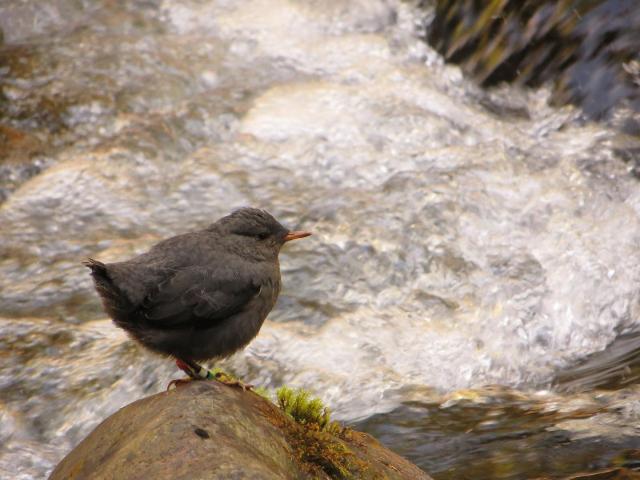Dec 28 2015
A songbird species that flourishes on the salmon-rich side of dams in the western United States struggles when it tries to nest on the side closed off from the fish and the nutrients they leave behind.
 An American dipper in a mountain stream is shown. Credit: Ohio State University
An American dipper in a mountain stream is shown. Credit: Ohio State University
But the songbird and the rest of the divided ecosystem rebounds, faster than some experts expected, when dams come down and rivers are allowed to resume their natural flow.
Two new studies led by Christopher Tonra, assistant professor of avian wildlife ecology at The Ohio State University, illustrate the stress dams impose on species that rely on salmon and the impact of dam removal on the well-being of that wildlife.
The areas previously depleted of salmon are on a fast track to recovery in a shorter time than he ever expected after the dam removal, Tonra said.
"It's exciting to be able to show a real positive outcome in conservation. We don't always get that," he said. "That these rivers can come back within our own generation is a really exciting thing."
During his time conducting the studies in Washington, Tonra watched reservoir beds that looked like moonscapes return to vibrant, rich habitat and cascades emerge where none had been, at least for the last century.
"Watching that happen was just incredible," he said.
Tonra and his colleagues studied the American dipper, a bird set apart by its unusual feeding style. Dippers, which are equipped with a transparent second eyelid (think water goggles for birds), dive below the river's surface and walk the riverbed scouring the rocky floor for meals, mostly aquatic insects in their larval stage. They also eat some small fish, including juvenile salmon when they're available.
The studies are the first to examine the effects of dams, and dam removal, on the dipper, considered an indicator species and the only bird of its type found in North America. Dippers that are faring well point to a strong ecosystem in and around the river.
"These birds are right where aquatic and terrestrial ecosystems meet," Tonra said.
Tonra and his colleagues spent four years in Washington's Olympic National Park and surrounding tribal, federal and private lands. The Elwha River winds through the park and is the site of the largest dam removal in history. Crews started tearing down the Elwha and Glines Canyon dams in 2011 and concluded in 2014, freeing the path for migratory fish for the first time in a century.
Salmon, which do most of their growing in the ocean, carry marine-derived nitrogen and carbon back into freshwater systems when they return to spawn and die. They benefit animals and plants, whether through direct consumption or because nutrients find their way into plants and other food, including larval mayflies and other insects for which the dipper dives.
"They're truly fertilizing the river and so that makes its way all the way up through the food chain," Tonra said.
In one study, the researchers documented that American dippers with access to salmon were in better physical condition and more likely to attempt multiple broods of offspring in a season. They also produced larger female offspring and were more likely to stay in breeding territories year-round. The research, published early online, will appear in an upcoming issue of the journal Ecography.
Tonra and his colleagues worked along four streams, three of which were blocked to salmon either by waterfalls or dams. They banded the birds, weighed them and collected blood samples. They looked at carbon and nitrogen in the birds' blood to determine their level of marine-derived nutrient intake.
The research team watched for multiple attempts to breed and an inclination to stay in the nesting area year-round, and tracked what type of food was delivered to nestlings.
The birds with salmon access had more marine-derived nutrients and were 20 times more likely to attempt multiple broods. They were 13 times more likely to stay year-round and had an annual adult survival rate that was 11 percent higher than their salmon-deprived peers.
The female birds with access to salmon had larger body mass, suggesting they were healthier. Fledgling females raised in areas with salmon also were larger.
The birds without access to salmon and food enriched by their presence "weren't in very good condition and it looked like they weren't attempting to breed as much," Tonra said.
And they took off after they fledged a single brood, presumably for salmon-rich waters.
"Within the same river you basically have two different populations," Tonra said.
There's good news in the team's second dipper study, published in the December 2015 issue of the journal Biological Conservation: Within a year of the Elwha Dam removal, Tonra and his colleagues were able to document an increase in salmon-derived nutrients in American dippers.
Tonra was surprised, and delighted, by how quickly the salmon returned.
"It was pretty much as soon as the first dam came out and fish were beating up against the second, wanting to go." Tonra, previously with the Smithsonian Migratory Bird Center, worked with Kimberly Sager-Fradkin of the Lower Elwha Klallam Tribe and Peter Marra of the Smithsonian on both studies. Sara Morley of the Northwest Fisheries Science Center and Jeffrey Duda of the Western Fisheries Research Center contributed to the study published in Biological Conservation.
Tonra said he'd like to return to the Pacific Northwest soon to measure changes in the birds' patterns and health since the dam removal. He's hopeful that other birds and bats that feast on insects in the air and on the trees near the river will become stronger as well.